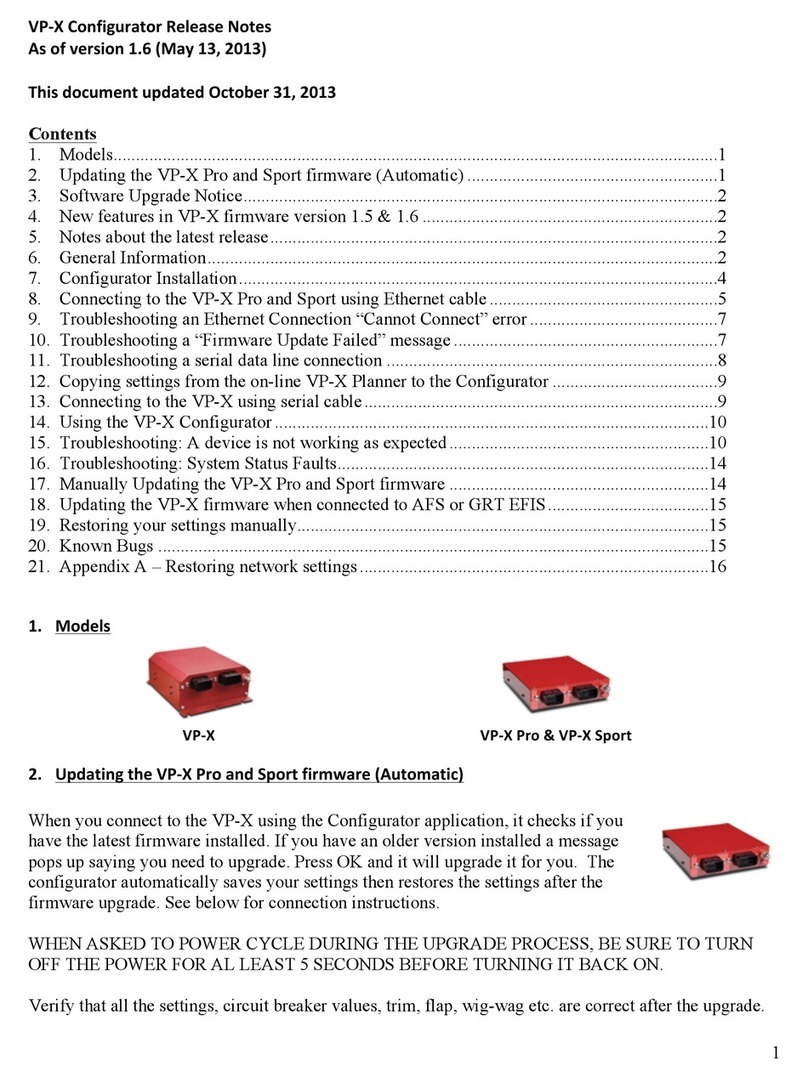
VP-X Installation and Operating Manual
Rev. D (August 5, 2020) Page 2
Important Notice
This manual contains important information that may affect the safety of your
aircraft. Do not y the aircraft until you fully understand the installation and
operating instructions, and all of the pre-ight checks have been successfully
completed.
Read the Limited Warranty document (Limited Warranty - Vertical Power Products)
available at www.verticalpower.com. There is information in the Limited Warranty that
may alter your decision to install this product. If you do not accept the terms of the
Limited Warranty, do not install this product. The product may be returned for a
refund if you do not accept the terms of the Limited Warranty.
Astronics is not liable or responsible for a pilot’s action or any situation that results in
personal injury, property damage, missed commitments, lack of use of an aircraft or
any expenses incurred due to: product failure, inaccuracy in displayed data or text les,
display or display format issues, software bugs or problems, upgrade or customization
issues, misinterpretation of the display, warning and/or limit settings, calibration
problems, installation issues (leaks, mis-wiring, obstructions, damage to aircraft or
components, incorrect installation of any parts, wrong parts, parts that don’t t, etc.) or
any other issues related to the installation or operation of this product. All of the above
are solely the pilot’s and/or installer’s responsibility.
The pilot must understand the operation of this product before ying the aircraft.
The pilot will not allow anyone to operate the aircraft that does not know the operation
of this product. The pilot will keep these Operating Instructions in the aircraft at all
times. The ability for this product to correctly control electronic components and detect
a problem is directly related to the pilot’s ability to properly install the system, and the
pilot’s interpretation and observation skills.
By installing this product, the aircraft owner/pilot and installer agree to hold Astronics
harmless and in no way responsible for monetary compensation, including punitive
damages for any incident, harm and/or damage associated with this product (including
but not limited to the ones listed above). If you do not agree to the above, DO NOT
INSTALL THIS PRODUCT. The pilot, aircraft owner and/or installer may want to obtain
an appropriate insurance policy before installing this product. If you do not have the
skills, knowledge, tools, equipment or facility, to perform and determine the installation
of this product is safe, reliable and accurate and to determine this product is operating
properly after installation, DO NOT INSTALL THIS PRODUCT. If the aircraft owner/pilot
and/or installer are unwilling to take the responsibility for the installation and operation
of this product, DO NOT INSTALL THIS PRODUCT. This product may be returned for
a refund by contacting Astronics.
It is possible for any system to fail thereby disabling electronic components or
displaying inaccurate high, low or jumpy readings. Therefore, you must be able to
recognize a system failure and you must be procient in operating your aircraft safely
in spite of a system failure. IT IS THE BUILDER AND/OR PILOT’S RESPONSIBILITY
TO DETERMINE THE APPROPRIATE LEVEL OF BACKUP AND REDUNDANT
SYSTEMS NEEDED FOR SAFE OPERATION OF THE AIRCRAFT. If you do not have
this knowledge or skill, contact the FAA, a certied aircraft mechanic, or a local ight
instructor for training prior to building or ying the aircraft with this system.
Before ying the aircraft verify the instrument markings displayed on the system are
accurate with your POH for every function displayed. Verify that each electrical device
is congured correctly and behaves appropriately. All data must be veried by the pilot
before it is used.
Before starting the installation, make sure that your planned installation will not interfere
with the proper operation of any controls. The installer should use current aircraft
standards and practices to install this product. Refer to AC 43.13-2A, Acceptable
Methods, Techniques, and Practices - Aircraft Alterations and AC 43.13-1B, Acceptable
Methods, Techniques, and Practices—Aircraft Inspection and Repair.
This is an experimental system limited to use in experimental aircraft or Light Sport
Aircraft. These products are not approved for use in aircraft with FAA or foreign type
certicates.
Limited Warranty
For warranty information, please refer to the Limited Warranty document (Limited
Warranty - Vertical Power Products) available at www.verticalpower.com.
Copyright Notice
Copyright ©2020 by Astronics. Astronics’ permission to copy and distribute this manual
is for the purchaser’s private use only and is conditioned upon purchaser’s use and
application with the hardware that was shipped with this manual. No commercial resale
or outside distribution rights are allowed by this notice. This material remains the
property of Astonics. All other rights reserved by Astronics.
Trademarks
Vertical Power is a registered trademark of Astronics. All other product names or
trademarks are property of their respective owners.
Astronics
The home of Vertical Power products
12950 Willows Road NE
Kirkland, WA 98034
Phone: +1.425.328.1658
Email: info@verticalpower.com




























